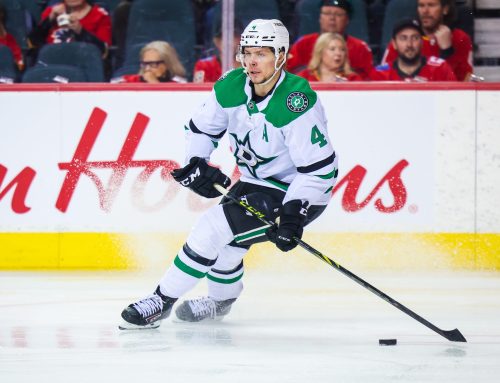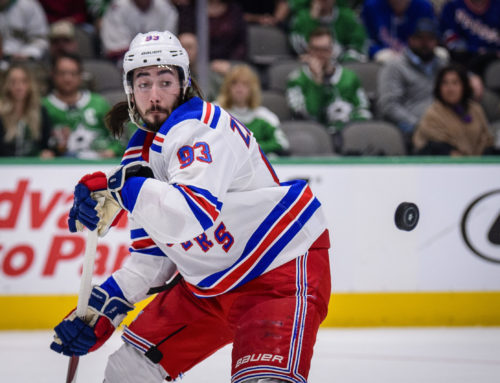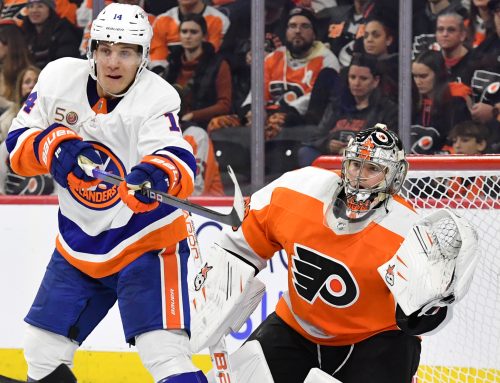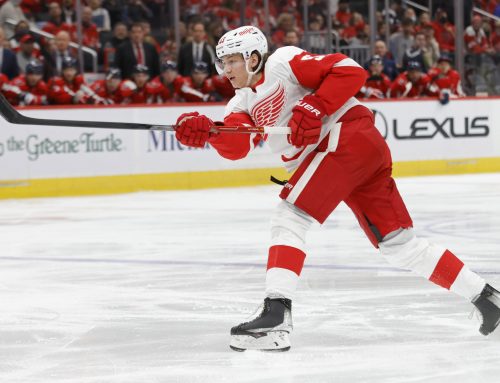Cage Match: Is Patrick Kane or Phil Kessel Better Bang for the Buck?
Rick Roos
2018-01-10

Better Bang for the Buck: Patrick Kane or Phil Kessel?
I always try to return with a bang after finishing a round of tournaments, plus I look for opportunities to revisit past matches which are still as relevant today. This week I kill two birds with one stone, as for my first match after three winter tournaments I rehash a 2014 battle by once again pitting Patrick Kane against Phil Kessel. Is a Panarin-less Kane no longer a threat for 90+ points in a season, and has Kessel morphed back into an 80+ point player in Pittsburgh? Cage Match is on the case!
Career Path and Contract Status
Kane, 29, was drafted first overall ten years ago and emerged with two point-per-game seasons among his first four. His scoring dipped in 2011-12, but then he rattled off three straight point-per-game seasons, although in two he missed more than 12 games, fueling concerns about a possible band-aid boy situation. Those fears were quelled by him playing all 82 games the past two seasons, posting 106 points then 89. There were concerns as to whether Kane’s scoring jump was tied to chemistry with Artemi Panarin, whose arrival coincided with Kane’s 106-point 2015-16 campaign but who was traded in the 2017 offseason. And considering that after 41 games Kane – sans Panarin – stood just below point-per-game scoring, some poolies worried he was no longer a threat to sit atop the NHL’s scoring leaders.
Kessel, 30, was drafted fifth overall a year earlier than Kane. Like Joe Thornton before him, Kessel was traded by Boston (to Toronto) just as he was emerging as a young star. With the Leafs Kessel started slowly, but then had a stretch of three seasons where he collectively averaged above point-per-game scoring. After dipping to 61 points in 2014-15, he was again traded, this time to the Pens, where he had a difficult first season, improved in 2016-17, and now stands above a point-per-game pace for 2017-18.
Kane’s contract counts $10.5M per season against the cap and expires in 2023, while Kessel, although no bargain, has a much lower ($6.8M per season) cap hit and his deal ends a year earlier.
Ice Time (2017-18 stats in this and other tables are current through January 8 games)
|
Season |
Total Ice Time per game (rank among team’s forwards) |
PP Ice Time per game (rank among team’s forwards) |
SH Ice Time per game (rank among team’s forwards) |
|
2017-18 |
20:10 (Kane) – 1st 18:44 (Kess) – 2nd |
3:50 (Kane)- 1st 4:05 (Kess) – 1st |
0:04 (Kane) – 10th 0:02 (Kess) –10th (tied) |
|
2016-17 |
21:23 (Kane) – 1st 17:56 (Kess) 3rd |
3:24 (Kane) – 1st 3:32(Kess) – 3rd |
0:04 (Kane) – 10th 0:00 (Kess) |
|
2015-16 |
20:24 (Kane) – 1st 18:22 (Kess) – 3rd |
3:07 (Kane) – 1st 3:30 (Kess) – 3rd |
0:02 (Kane) – 13th (tied) 0:01 (Kess) – 18th (tied) |
|
2014-15 |
19:51 (Kane) – 1st 18:47 (Kess) – 3rd |
3:40 (Kane) – 1st 3:41 (Kess) – 1st |
0:02 (Kane) – 11th 0:00 (Kess) |
This data supports that Artemi Panarin’s presence helped take Kane’s production to the next level. After all, Kane’s 2014-15, 2015-16 and 2017-18 numbers are pretty comparable overall, yet 2015-16 saw him score 106 points whereas in 2014-15 and thus far this season he has produced at more like a point per game. This is discouraging news to Kane owners, as is the fact that Kane is set to turn 30 next season, and no NHL player age 30+ has scored 90+ points in a season since 2010-11.
Underscoring the importance of Frozen Pool, it would seem Kane’s PP usage is better this season than in any of the past three. Although that is true in terms of pure minutes, the reality is due to Chicago drawing more penalties than in past seasons it translates to him being on the ice for under 60% of the club’s overall PP time this season, versus 70% last season and 63% in each of the prior two. Thus, not only is Kane’s overall ice time down a minute from last season, his PP usage is worse.
With Kessel, it is difficult to see how he is scoring above a point per game clip when in each of his previous three seasons he managed 59-70 points with similar deployment. Looking deeper, we see last season he stood at 41 points in 40 games before finishing with 29 in his final 41 contests. Yet in 2015-16 he started slow (22 points in 39 games) then finished strong (37 points in 43 games). If his pattern of one good half and one bad holds true, he is due to slump over the rest of this season. What might trump that pattern, however, is his “magical third year” track record. With the B’s, he went from 37 points in 80 games in his second season to 60 in 70 contests in his third. With Toronto, his second-year output was 64 points in 82 games, then next season it was 82 points. This is his third Pens campaign, suggesting he is due for a jump in scoring, or at least mitigating against a second half collapse.
Secondary Categories
|
Season |
PIMs (per game) |
Hits (per game) |
Blocked Shots (per game) |
Shots (per game) |
PP Points (per game) |
|
0.44 (Kane) 0.63 (Kess) |
0.19 (Kane) 0.18 (Kess) |
0.14 (Kane) 0.27 (Kess) |
3.53 (Kane) 3.59 (Kess) |
0.25 (Kane) 0.61 (Kess) |
|
|
2016-17 |
0.39 (Kane) 0.24 (Kess) |
0.34 (Kane) 0.14 (Kess) |
0.08 (Kane) 0.18 (Kess) |
3.56 (Kane) 2.79 (Kess) |
0.28 (Kane) 0.36 (Kess) |
|
2015-16 |
0.36 (Kane) 0.22 (Kess) |
0.45 (Kane) 0.11 (Kess) |
0.25 (Kane) 0.16 (Kess) |
3.50 (Kane) 3.34 (Kess)
📢 advertisement:
|
0.45 (Kane) 0.20 (Kess) |
|
2014-15 |
0.16 (Kane) 0.36 (Kess) |
0.36 (Kane) 0.22 (Kess) |
0.23 (Kane) 0.16 (Kess) |
3.05 (Kane) 3.41 (Kess) |
0.36 (Kane) 0.30 (Kess) |
The number that jumps off the page is Kessel’s PPPt rate for 2017-18. Consider that from 2013-14 through 2016-17, he had the 13th most PPPts of any NHL forward, yet by Game 44 of 2017-18 he already has more PPPts that he did in all 82 games in three of his past four campaigns! No way is this remotely sustainable; however, if his IPP is stable (which we’ll check below), his overall scoring pace could remain intact by his even strength scoring rising to offset lost PPPts.
Kessel’s 2017-18 SOG rate is up considerably and on pace for 290+, yet that isn’t necessarily great news. In the five campaigns Kessel fired 280+ SOG, his point totals were 55 (in 70 games), 64, 82, 80, and 61. Also, in neither of Kessel’s two seasons where he had 25+ PPPts did he manage to top even 70 points. What was the key ingredient to Kessel’s best outputs? Seemingly ice time, as he averaged 19:48+ per game in each campaign that saw him post his best outputs. That could be an issue, as since 2006-07 the only Pens forward other than Sidney Crosby or Evgeni Malkin to average 19:09+ per game in any season was Jordan Staal, who did it twice but thanks mainly to 2:30+ of shorthanded ice time per game both times.
As for Kane, his 2017-18 SOG and PPPt rate are essentially tracking 2016-17 thus far; yet his scoring this season is lower. Before we pin that on the non-Panarin effect, let’s not forget Kane’s ice time and share of PP minutes are down as well. It stands to reason that unless he has been unsustainably unlucky thus far for 2017-18, and assuming he continues to be deployed similarly in the second half, he might have a tough time producing more than 80 points, if even that much.
Notice I haven’t mentioned hits or blocked shots? That’s because it should be no secret that both are proven poor producers in these areas, even accounting for them being high scorers.
Luck-Based Metrics
|
Season |
Personal Shooting % |
Team Shooting % (5×5) |
Individual Points % (IPP) |
Offensive Zone Starting % (5×5) |
Average Shot Distance |
Secondary Assists % |
|
2017-18 |
11.7% (Kane) 11.5% (Kess) |
8.40% (Kane) 5.83% (Kess) |
76.9% (Kane) 72.3% (Kess) |
64.6% (Kane) 66.0% (Kess) |
28.5 (Kane) 30.3 (Kess) |
34% (Kane) 38% (Kess) |
|
2016-17 |
11.6% (Kane) 10.0% (Kess) |
9.54% (Kane) 8.83% (Kess) |
74.2% (Kane) 67.3% (Kess) |
62.6% (Kane) 62.5% (Kess) |
27.0 (Kane) 30.2 (Kess) |
34% (Kane) 47% (Kess) |
|
2015-16 |
16.0% (Kane) 9.5% (Kess) |
10.08% (Kane) 8.29% (Kess) |
79.7% (Kane) 59.6% (Kess) |
66.6% (Kane) 63.2% (Kess) |
27.9 (Kane) 28.5 (Kess) |
31% (Kane) 33% (Kess) |
|
2014-15 |
14.5% (Kane) 8.9% (Kess) |
8.76% (Kane) 6.81% (Kess) |
72.7% (Kane) 73.5% (Kess) |
66.6% (Kane) 49.8% (Kess) |
26.9 (Kane) 32.3 (Kess) |
32% (Kane) 52% (Kess) |
Looking at Kane’s metrics, there is no denying he was, and remains, elite – with or without Panarin. His IPPs have been above the key 70% threshold not just in these four seasons, but seven of the past eight. Plus, his secondary assists percentage and ASD are unwavering, and further reinforce he is the key to goals being scored while on the ice. But this also means he needs a finisher, as otherwise what would be primary assists don’t become goals and, in turn, don’t result in Kane getting points.
Moreover, through December Kane had nearly 30% more points than the next highest Blackhawk. But before dismissing that as a barrier to Kane being a 90+ point scorer again, if we look at all nine instances of 90+ points being scored by just one player on a team since 2010-11, eight featured the player tallying 23%+ more points than anyone else on his team. Further to what I noted above about age and 90+ point scoring though, seven of the eight were age 26 or younger. The eighth was Kane at age 27 during the 2015-16 season; but now that he’s 29 it might be a stretch for him to once again taste 90+ points.
Sure enough, Kessel’s IPP is reasonable. Thus, if/when his PPPt rate drops, his ES scoring could increase enough to sustain his overall production. His OZ% also is well higher than the 43%-52% during his best years in Toronto. That means while he’s not receiving 19:48+ in ice time as he was when scoring at an 80+ point pace as a Leaf, between the nearly 19:00 he’s getting now as a Pen and his 66% OZ%, his deployment this season is arguably better than in past productive campaigns with Toronto. Moreover, his team shooting percentage is well below 8.29%, a threshold he failed to meet just once since 2011-12.
Who Wins?
If this was only about picking the pure better player, the winner would be Kane. But when dealing with players who are both elite, cost vs. value and positional eligibility come into play.
In most leagues, both are only RW eligible, so that’s a wash. As for cost vs. value, Kane will cost you considerably more in draft than Kessel, as Kane was drafted, on average, with pick 3.4 versus pick 29.5 for Kessel in 2017-18 Yahoo leagues. And as for trade cost, Kane is the marquee player (and a former Hart Trophy winner) on an original six team, whereas Kessel is overshadowed by Sidney Crosby and Evgeni Malkin in Pittsburgh, which is a very popular team but arguably not on quite the same level as the Blackhawks.
Thus, it’s fair to say that if Kessel can give you 90% of Kane’s output, but at only 80% of Kane’s cost, Kessel could be the winner. And that’s indeed my decision here – Kessel wins.
Kessel is as sure bet for 82 games per season as any NHLer (certainly more so than Kane), plus he now matches Kane’s OZ%, and is a force on Pens PP1 that, frankly, puts Chicago’s to shame. Kane, on the other hand, is seeing fewer minutes than in any recent season, plus substandard PP usage. Although that will incent him to do more himself, it might not be enough to get him much more than 80 points, if even that high, now and going forward. And considering I think Kessel is a virtual lock for 80 this season and 75+ in near future campaigns, he becomes the better cost vs. value player and wins the match.





 BUF
BUF N.J
N.J PHI
PHI MIN
MIN VAN
VAN FLA
FLA TOR
TOR CGY
CGY WPG
WPG